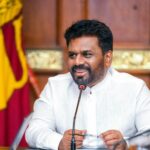
Sri Lanka’s Economic Shift: Embracing State-Led Growth Amidst IMF Conditions
- CNL Reporter
- November 16, 2024
- Weekly Economic Review
- IMF Conditions, Sri Lanka’s Economic
- 0 Comments
Weekly Economic review
In a significant political turn of events, the National People’s Power-led government, under the leadership of President Anura Kumara Dissanayake, has begun its journey through a new economic perspective after winning a landslide victory in the parliamentary election, capturing 159 seats-two-thirds for the first time. The political success has opened a pathway toward a mixed economic approach: besides following state-led growth, there is an inclination toward neoliberalism through the IMF’s Extended Fund Facility.
Balanced Economic Approach
The government has thus assumed a two-track policy. While it indeed advocates state-driven economic development and retains the commanding heights of the economy under state control, this does not, on the other hand hinder its continued embracing some neoliberal policies, as also illustrated by the conditions imposed by the IMF. According to President Dissanayake, only non-essential sectors of the economy have been opened to private ownership, with the “commanding heights” still retained under the state’s control. It is such a mix of statism and market-based reforms that have been adopted as pragmatic compromise, which would not lead to instability in the economy and at the same time would be viewed as sticking to IMF-prescribed guidelines.
The government has consciously adopted the EFF program of the IMF to avoid a disruptive economic shock by maintaining financial stability. This is highly challenging, particularly regarding how the government manages between 300 and 500 underperforming state-owned enterprises, out of which 52 are key ones. Even as the IMF has called for this, the neoliberal elements are being balanced with state-driven initiatives by the government.
Short term Economic Challenges
The NPP Government is in the difficult process of balancing state control with market reforms. In adopting a pragmatic, mixed economic policy, this government seeks to encourage growth in a stable economy while phasing out dependence on domestic and international borrowing. This approach will be seen as centered on the SOEs reform and observance of IMF conditions-as an assurance of long-term fiscal stability coupled with retention of direct state involvement in key sectors of the economy.
As the government moves forward with its program of economic reform, such measures will be watched with interest for their success
Positive Revenue Growth amid Fiscal Reforms
Recent fiscal data shows some successes. For the first eight months of 2024, Sri Lanka’s revenues surged 41% to 2,348 billion rupees, beating a full-year target of a 35% rise. Non-tax revenues also rose significantly from 158 billion rupees last year to 209 billion rupees. These were underpinned by ncreased tax rates and a stable monetary environment.
Expenditure: Current spending was compressed to only a 3% rise to 3,041 billion rupees with the help of wage restraint and a lower-than-expected interest bill. Capital spending jumped by 22%, however, to 435.3 billion rupees. This good management of revenues and spending thereby cut the overall deficit by 38% compared with the previous year and contained domestic borrowings at manageable levels.
Fuel Subsidies and Benefits for State Workers
In a balancing act between economic reforms and the welfare of the people, President Dissanayake announced on Tuesday that the government is considering fuel subsidies for the fishing and agricultural sectors, a policy previously mooted by former president Ranil Wickremesinghe himself. This will no doubt help cushion these very important industries, but the rest of the population remains burdened with high taxes to support the sustainability of the nation’s debt.
Thirdly, there will be an increase in state employees’ salaries next year, the much-needed readjustment since, after the 2022 currency crisis, real value savings greatly went down.
Reforming State-Owned Enterprises
Among the strong pivots of the government’s economic agenda are comprehensive reforms in state-owned enterprises. The government has already taken a range of measures from cost-effective pricing of electricity and fuel, to the balance sheet restructuring of key SOEs and opening up participation of private firms in the petroleum sector. A few of the reforms have thus far begun to bear their fruits as the 52 major SOEs in the first half of 2024 recorded a profit of 280.7 billion rupees compared to 193.5 billion during the same period in 2023.
However, Prof. Anil Jayanta, senior economic adviser to the government said that SOEs would face a complete restructuring process with transparent and efficient economic frameworks. Since these enterprises face different kinds of challenges, there is very little possibility that they would be treated under one solution. The government could thus take various strategies that could match the specific conditions of each of the SOEs.
Challenges of Restructuring and Accountability
Reforming SOE has not been easy. Accountability, restructuring, and privatization of these organisations faced criticism over these years because of political pressures and opposition from labor unions. A plan to establish one super holding company with powers over SOEs- a situation similar to Singapore’s Temasek-is not going down well with ministers who are believed to be wary of losing influences over line ministries.
Nevertheless, public opinion appears to favor radical steps concerning ineffective SOEs. The government has to weigh restructuring against maintaining political popularity since the other alternatives, for instance, raising taxes or reducing state expenditures, will also be less popular.
The only way these targets could be achieved by the IMF would be to make drastic changes in the SOEs. Greater accountability, restructuring, possible privatization, and the use of a central holding entity are some of the strategies that are being considered. These will help to ease fiscal pressure on domestic banks, have better access to financing and reduce labor costs for the private sector.
The Future of Sri Lankan Airlines
One of the most remarkable decisions in the SOE sector was the decision not to privatize SriLankan Airlines, a stand upheld by the previous regime of former President Wickremesinghe, too. Due to operational inefficiencies and past issues with its debt, the airline has been a burden for many years. In March 2024, Cabinet approved the transfer of the airline’s Treasury-guaranteed debt, at a value of USD 310 million, to the government’s balance sheet.
While the General Treasury has supported the airline with equity injections and loan guarantees, SriLankan Airlines has kept struggling financially. Revenue for the carrier dropped 12.7% on the year-earlier period in the three months to June 2024. It recorded a net loss of 12.9 billion rupees in the same period, versus the profit of 25.8 billion rupees during the previous comparative period.
Greater Economic Challenges
The issues at the SOEs, among them SriLankan Airlines, mirror greater economic challenges. Historically, these entities have been saddled by mismanagement, overstaffing, inadequate financial transparency, and poor budget controls. Reforms of such institutions are very vital in the wider fiscal health of Sri Lanka, considering the country’s efforts to meet the guidelines set by the IMF with a view to reducing the overall fiscal deficit.

